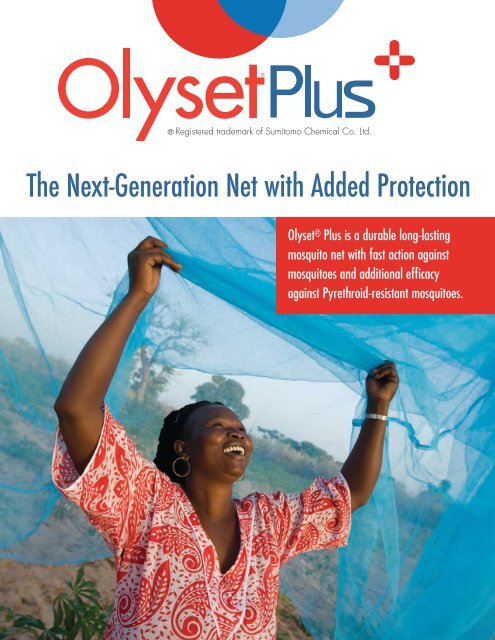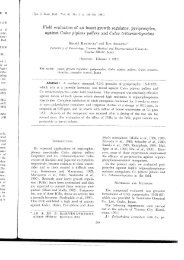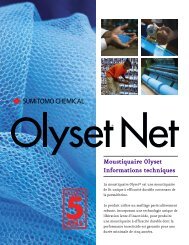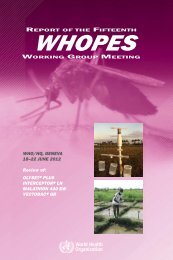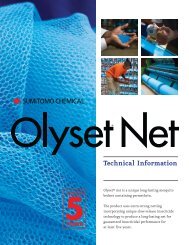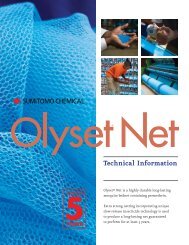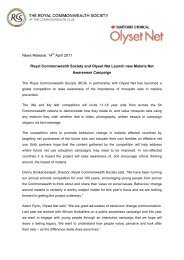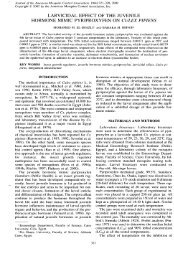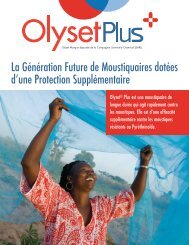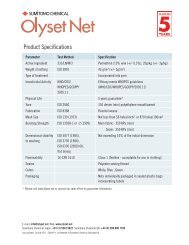Download PDF - Olyset Net
Download PDF - Olyset Net
Download PDF - Olyset Net
Create successful ePaper yourself
Turn your PDF publications into a flip-book with our unique Google optimized e-Paper software.
Registered trademark of Sumitomo Chemical Co. Ltd.<br />
The Next-Generation <strong>Net</strong> with Added Protection<br />
<strong>Olyset</strong> ® Plus is a durable long-lasting<br />
mosquito net with fast action against<br />
mosquitoes and additional efficacy<br />
against Pyrethroid-resistant mosquitoes.
<strong>Olyset</strong> Plus – meeting the world’s changing needs.<br />
Contents<br />
Introduction and Background....................................................................1<br />
Controlled Release Technology ................................................................5<br />
Biological Efficacy ......................................................................................6<br />
Technical Specifications ..........................................................................10<br />
Usage and Safety ......................................................................................12
Introduction and Background<br />
Introduction<br />
Mosquito nets have a long history of protecting people<br />
from malarial mosquitoes but it was not until the introduction<br />
of treating nets with pyrethroid insecticides that<br />
bed nets changed from being a physical barrier to being<br />
an insecticidally active tool which both deters and kills<br />
mosquitoes. The original method of dipping nets in<br />
insecticide solution was very labour intensive and<br />
logistically difficult in the field and the treatment rarely<br />
survived more than three washes. The situation changed<br />
dramatically with the introduction of factory-treated,<br />
wash-proof, long lasting insecticide treated nets (LLINs)<br />
in which the insecticide is either bound to the surface of<br />
the net fibre or incorporated inside the fibre itself.<br />
<strong>Olyset</strong> ® <strong>Net</strong> – Pioneering Technology with Added Durability<br />
Sumitomo Chemical was the first company to develop and<br />
pioneer fibre incorporation technology. We realised that<br />
incorporation of insecticide into the fibre, using controlled<br />
release technology that allows insecticide to migrate to<br />
the surface and maintain a regular supply, is better than<br />
`gluing` to the fibre surface which leaves the insecticide<br />
vulnerable to removal by abrasion or washing. In addition,<br />
the use of high-density polyethylene (HDPE) rather than<br />
polyester as the fibre material gives major advantages in<br />
both the strength and durability of the net. <strong>Olyset</strong> Plus,<br />
like the original <strong>Olyset</strong> <strong>Net</strong>, has a denier of >150 whereas<br />
commonly available polyester nets are 75 – 100 denier. As<br />
denier is one of the major contributors to strength and<br />
durability in the field, <strong>Olyset</strong> Plus is therefore approximately<br />
1.5 - 2 times stronger than typical 75 – 100 denier<br />
polyester LLINs.<br />
<strong>Olyset</strong> <strong>Net</strong> was the first LLIN to pass the World Health<br />
Organization Pesticide Evaluation Scheme (WHOPES).<br />
Since then, many more nets have passed WHOPES with<br />
either interim or full recommendation. However, all these<br />
nets—including <strong>Olyset</strong> <strong>Net</strong>—are manufactured using a<br />
single class of insecticides known as pyrethroids, on<br />
account of their excellent activity against mosquitoes and<br />
low mammalian toxicity.<br />
Emerging insecticide resistance – a real threat<br />
Due to the excellent results from using LLINs, donors<br />
campaigned and advocated for mass distribution of bednets<br />
throughout Africa and in many other endemic countries.<br />
Universal coverage (at least 80% coverage with LLINs of<br />
at-risk populations) was achieved in many African<br />
countries by early 2011. The pressure of only using<br />
pyrethroids in LLINs, and their extensive use in indoor<br />
residual spraying programs as well as in agriculture, has<br />
resulted in insecticide resistance in mosquito vector<br />
populations in some parts of the world, particularly in<br />
Africa. ‘At the time of this report, resistance to at least<br />
one insecticide has been identified in 64 countries with<br />
on-going malaria transmission. Resistance to pyrethroids<br />
Key Features<br />
• Fine mesh.<br />
• Softer feel.<br />
• Excellent biological performance<br />
against mosquitoes.<br />
• Enhanced knockdown and kill<br />
against pyrethroid-resistant<br />
mosquitoes.<br />
• Contains the synergist –<br />
piperonyl butoxide (PBO) on<br />
all surfaces.<br />
• Insecticide and synergist<br />
incorporated inside fibres.<br />
• Insecticide and synergist<br />
migrate to fibre surface<br />
continuously over many years.<br />
• Re-generation of both<br />
active ingredients.<br />
• Unique to market.<br />
• A second generation of the<br />
well proven <strong>Olyset</strong> <strong>Net</strong>.<br />
• Japanese technology.<br />
seems to be the most widespread.*’ The extent and<br />
threat of resistance to the use of LLINs and on actual<br />
malaria cases is not well understood and there are large<br />
programmes planned to monitor and check the impact<br />
on transmission.<br />
* WHO Global Plan for Insecticide Resistance Management in malaria<br />
vectors (GPIRM), 2012<br />
1
Figure 1. Possible scenario for resistance development<br />
in a mosquito population.<br />
Reproduced by kind permission of IRAC<br />
Figure 2. Distribution of pyrethroid resistance in Africa using<br />
data collected between 2000 to 2010.<br />
Sumitomo Chemical’s original <strong>Olyset</strong> <strong>Net</strong> remains one<br />
of the best and most durable LLINs on the market.<br />
However, Sumitomo recognised that for some markets<br />
improvements could be made by increasing the speed of<br />
action and efficacy against both susceptible and resistant<br />
mosquitoes. This led to the development of <strong>Olyset</strong> Plus.<br />
<strong>Olyset</strong> Plus introduces many new features, including<br />
the addition of piperonyl butoxide (PBO), a synergist<br />
which increases the performance of the active ingredient<br />
Permethrin and in particular enhances activity against<br />
pyrethroid-resistant mosquitoes (see below for more<br />
information on PBO).<br />
<strong>Olyset</strong> Plus is the first and only net on the market to<br />
incorporate PBO into every fibre and all surfaces of the<br />
net, providing enhanced knockdown and kill against<br />
pyrethroid-resistant mosquitoes.<br />
Insecticide Resistance<br />
Insecticide resistance is defined by the Insecticide<br />
Resistance Action Committee (IRAC) as: ‘a heritable change in<br />
the sensitivity of a pest population that is reflected in the repeated<br />
failure of a product to achieve the expected level of control when used<br />
according to the label recommendation for that pest species.’<br />
The development of insecticide resistance occurs for the<br />
following reasons:<br />
Key:<br />
An. pharoensis<br />
An. labranchiae<br />
An. funestus<br />
An. gambiae s.l.<br />
An. arabiensis<br />
An. gambiae s.s.<br />
Resistant<br />
Resistance suspected<br />
Susceptible<br />
Ranson et al, Trends in Parasitology, February 2011, Vol. 27, No. 2.<br />
• Natural selection allows pre-adapted insects with<br />
resistance genes to survive and pass this resistance trait<br />
onto off-spring.<br />
• As more product is applied, the resistant population<br />
keeps growing while the susceptible individuals are<br />
eliminated by the insecticide. The product therefore<br />
is no longer fully effective.<br />
Other key points to note :<br />
• Speed of resistance development depends on speed of<br />
reproduction, the persistence of the insecticide applied<br />
and the proportion of susceptible species.<br />
• Resistance has appeared in a wide range of public<br />
health vectors to most chemical classes of insecticides.<br />
• The resistance problem in vector control is exacerbated<br />
2
y extensive use and misuse of the same classes of<br />
insecticides in agriculture.<br />
The map (see Figure 2) indicates that there is a spread of<br />
pyrethroid resistance into many areas of Africa where<br />
LLINs are being deployed. While the impact of this resistance<br />
on the efficacy of LLINs and malaria transmission is<br />
still unknown, there is a growing consensus that high<br />
levels of resistance may in the future result in operational<br />
failure of mass LLIN distribution programmes. Insecticide<br />
resistance in malaria vectors is therefore one of the major<br />
issues concerning stakeholders today.<br />
There are several types of resistance mechanism:<br />
• Metabolic resistance.<br />
• Target site resistance (Knockdown resistance (Kdr)<br />
or nerve insensitivity).<br />
• Behavioural resistance.<br />
• Reduced penetration resistance.<br />
Amongst these mechanisms, metabolic resistance is<br />
probably the most important, although the impact of Kdr<br />
resistance is also significant. The only chance to overcome<br />
most types of resistance is by using a totally new class of<br />
insecticide which as yet is not available. Ideally, a new<br />
insecticide would have all the attributes of pyrethroids:<br />
<strong>Olyset</strong> Plus is the first and only net on the market to<br />
incorporate PBO into every fibre and all surfaces of<br />
the net, providing enhanced knockdown and kill<br />
against pyrethroid-resistant mosquitoes.<br />
fast action, high intrinsic activity against target insects,<br />
and low mammalian toxicity combined with ease of<br />
formulation. These characteristics make the task of<br />
identifying suitable chemistry an extremely challenging,<br />
costly and long-term undertaking.<br />
While companies such as Sumitomo Chemical are<br />
playing a leading role in the synthesis, screening and<br />
development of new chemistry for use in disease vector<br />
control, the best solution in the interim is to continue to<br />
formulate LLINs with pyrethroids and to use the synergistic<br />
properties of PBO to improve insecticidal activity<br />
against both susceptible and resistant mosquitoes.<br />
For further information on insecticide resistance,<br />
monitoring and management strategies see `Prevention<br />
and Management of Insecticide Resistance in Vectors of<br />
Public Health Importance` published by IRAC (CropLife<br />
International) – see (www.irac-online.org)<br />
What is <strong>Olyset</strong> Plus<br />
<strong>Olyset</strong> Plus is a durable polyethylene net containing 2%<br />
permethrin and 1% of the synergist piperonyl butoxide<br />
(PBO) which are incorporated in all fibres. In this way,<br />
all sides and also the roof are treated. Using Sumitomo<br />
Chemical’s unique <strong>Olyset</strong> controlled-release technology, net<br />
fibres have been designed to release the two ingredients at<br />
a constant ratio of 2:1 thus ensuring enhanced efficacy for<br />
the life of the net against all mosquitoes, including those<br />
which are resistant.<br />
It has been shown that while many mosquitoes<br />
approach the roof of the LLINs a similar proportion go to<br />
the sides to get at the sleeping host. (Ref. Severin, L.<br />
University d` Abomey – Calavi Calvi, pers. comm.)<br />
Based on the above, it is clear that any net seeking to<br />
provide enhanced levels of protection from susceptible and<br />
3
esistant insects should have PBO on all surfaces so that<br />
the mosquitoes cannot avoid contacting both insecticide<br />
and synergist at the same time.<br />
What is Piperonyl Butoxide<br />
Piperonyl butoxide (PBO) is a synergist which has long<br />
been used to improve the performance of pyrethroid<br />
insecticides especially household aerosols. Synergists are<br />
chemicals that lack insecticidal activity of their own but<br />
enhance the insecticidal performance of other chemicals.<br />
How does Piperonyl Butoxide combat resistance<br />
All insects, whether susceptible or resistant, have enzymes<br />
that can metabolise insecticides into harmless components.<br />
Some of these enzymes, known as cytochrome P450s, are<br />
powerful oxidising agents that can detoxify an active<br />
ingredient before the desired effect is achieved; PBO is a<br />
powerful inhibitor of these enzymes and therefore blocks<br />
this action.<br />
In resistant insects the activity of these enzymes can<br />
be greatly enhanced which can significantly reduce the<br />
efficacy of an insecticide. PBO acts on these enzymes in<br />
resistant insects and inhibits the breakdown or the<br />
metabolism of insecticides, rendering the insecticide more<br />
effective. PBO also increases the activity of pyrethroids to<br />
susceptible insects, so adding PBO to an LLIN has a benefit<br />
even in areas where there is no resistance.<br />
There are many scientific papers which demonstrate<br />
the impact of PBO on pyrethroid resistance, and some<br />
specifically highlight the impact on permethrin resistance.<br />
See for example: Evidence of multiple pyrethroid resistance<br />
mechanisms in the malaria vector Anopheles gambiae sensu stricto<br />
from Nigeria. Awolola, T.S. et al., Transactions of the Royal Society<br />
of Tropical Medicine and Hygiene Vol: 103, Issue: 11, Pages: 1139-<br />
1145 (2009).<br />
Piperonyl Butoxide Key Points:<br />
• Inhibitor of P450 enzymes.<br />
• Enhances insecticide penetration.<br />
• Used in many household aerosols and space sprays<br />
products.<br />
• Not an insecticide but a synergist.<br />
• Low mammalian toxicity.<br />
• Known and used for >50 years.<br />
<strong>Olyset</strong> Plus Regeneration<br />
Rapid regeneration of surface active ingredients after<br />
washing -- and therefore the provision of an almost<br />
continuously available insecticide plus PBO barrier against<br />
mosquitoes -- is required to maximise the protective effect.<br />
This is especially important in areas where resistant mosquitoes<br />
have been found. The rate at which permethrin<br />
and PBO migrate from the internal reservoir in the fibre<br />
to the surface of the net (known as the ‘bleed rate’) has<br />
been adjusted in <strong>Olyset</strong> Plus to provide a rapid rate of<br />
regeneration, making the net active again within 1 – 2<br />
days after washing.<br />
Full efficacy in less than 2 days after washing.<br />
4
Controlled Release Technology<br />
Incorporated Polyethylene Controlled-Release Fibres vs “Coated” Polyester Fibre<br />
Permethrin and PBO<br />
Year 1 Year 2 Year 3<br />
Standard <strong>Net</strong><br />
Above: <strong>Olyset</strong> Plus, permethrin and piperonyl<br />
butoxide migrate to the surface of the net fibre over<br />
a period of three years or longer, maintaining a<br />
biologically effective surface concentration.<br />
Insecticide particles<br />
“glued” to net surface<br />
Left: For “coated” LLINs, surface concentration<br />
of insecticide declines over time.<br />
Year 1 Year 2 Year 3
Biological Efficacy<br />
The objectives of testing <strong>Olyset</strong> Plus were as follows:<br />
• Confirm efficacy meets WHOPES standards.<br />
• Confirm the regeneration time for insecticide and<br />
synergist is rapid.<br />
• Evaluate efficacy against susceptible mosquitoes.<br />
• Evaluate efficacy against pyrethroid resistant<br />
mosquitoes.<br />
% mortality<br />
% KD at 60 minutes<br />
%<br />
Figure 3. <strong>Olyset</strong> Plus tested unwashed and at intervals after<br />
three times washing — mortality at 24 hours.<br />
100<br />
80<br />
60<br />
40<br />
20<br />
0<br />
100<br />
80<br />
60<br />
40<br />
20<br />
0<br />
100<br />
64<br />
74<br />
85 85 87 87 84<br />
0 1 2 3 4 5 6 7<br />
Days post-washing<br />
Rossignol, B. Luce, MN Lacroix and F. Chandre, DOC/LIN/IRD/01/11<br />
Figure 4. Effect of washing <strong>Olyset</strong> Plus net (WHO cone test)<br />
100<br />
80<br />
60<br />
40<br />
20<br />
0<br />
100 100 100 99 99<br />
0 3 5 10 15 20 25<br />
Number of washes<br />
Rossignol, B. Luce, MN Lacroix and F. Chandre, DOC/LIN/IRD/01/11<br />
Figure 5. Speed of regeneration of <strong>Olyset</strong> Plus against field<br />
caught pyrethroid resistant mosquitoes (WHO cone test).<br />
100<br />
100<br />
<strong>Olyset</strong> Plus<br />
unwashed<br />
100<br />
73.2<br />
<strong>Olyset</strong> Plus<br />
washed<br />
KD<br />
Mortality<br />
Ref. Sumitomo Chemical Health and Crop Sciences Laboratory Report, 2011<br />
95 95<br />
1. Regeneration, wash resistance and efficacy of <strong>Olyset</strong> Plus against<br />
susceptible Anopheles gambiae.<br />
To evaluate speed of regeneration, <strong>Olyset</strong> Plus was tested<br />
unwashed and then washed and dried 3 times and tested<br />
each day afterwards. Results (Figure 3) demonstrate that<br />
the net rapidly recovers killing efficacy and retained 100%<br />
knockdown activity after washing. From this (noting the<br />
fact that confidence intervals for mortality between day 2<br />
and 7 overlapped) regeneration time was determined to be<br />
2 days.<br />
To evaluate wash resistance nets were tested after<br />
repeated washing using the cone test. From the data<br />
generated above the interval between washes was set at 2<br />
days to allow the net to fully regenerate. Results indicate<br />
that knockdown (KD) of mosquitoes exposed to <strong>Olyset</strong><br />
Plus hardly changes over 25 washes. As these tests were<br />
conducted only 24 hours after each washing, the rapid<br />
regeneration of active ingredient on the fibre surface is<br />
clearly shown (See Figure 4).<br />
2. Evaluation of <strong>Olyset</strong> Plus vs. <strong>Olyset</strong> Plus without PBO unwashed<br />
and one day post washing against field caught pyrethroid resistant<br />
mosquitoes.<br />
Tests were conducted using the World Health Organisation<br />
(WHO) cone method (3 minute exposure) against field<br />
caught Anopheles arabiensis which were metabolic mechanism<br />
pyrethroid resistant. <strong>Olyset</strong> Plus was very effective<br />
unwashed and had regenerated very rapidly after 1 day to<br />
give 100% KD and 73.2% mortality (See Figure 5).<br />
3. Evaluation of <strong>Olyset</strong> Plus two days after 20 washes against<br />
pyrethroid resistant mosquitoes using the WHO tunnel test.<br />
<strong>Olyset</strong> Plus was washed 20 times using the standard<br />
WHO method and then tested in the WHO tunnel test only<br />
2 days after the last wash against Anopheles gambiae G3<br />
strain (moderately metabolic resistant to pyrethroids).<br />
Mosquitoes were introduced at one end of the tunnel and<br />
a small animal at the other end. The netting sample was<br />
placed in between with nine holes cut in it according to<br />
the WHO protocol. If mosquitoes can pass through the<br />
holes in the net this indicates the net has little repellency<br />
6
or killing effect. Blood Feeding Inhibition (BFI) shows the<br />
percentage of mosquitoes prevented from reaching the animal<br />
and feeding. Mortality is the total number of mosquitoes<br />
killed in their attempts to feed.<br />
Figure 6. <strong>Olyset</strong> Plus 2 days after 20 washes against<br />
pyrethroid-resistant mosquitoes (WHO Tunnel test).<br />
100<br />
80<br />
94.6<br />
79.6<br />
Sumitomo Chemical was the first company to develop<br />
and pioneer fibre incorporation technology.<br />
%<br />
60<br />
40<br />
20<br />
0<br />
BFI<br />
Mortality<br />
Results (Figure 6) show that blood feeding inhibition<br />
was very high and mortality was almost 80% despite the<br />
mosquitoes being pyrethroid resistant. This test demonstrates<br />
how quickly efficacy is restored to <strong>Olyset</strong> Plus<br />
following 20 washes and only 2 days regeneration time.<br />
4. <strong>Olyset</strong> Plus vs. a Polyester LLIN against field caught pyrethroid<br />
resistant mosquitoes.<br />
These tests were conducted against field caught Anopheles<br />
arabiensis which are pyrethroid metabolic resistant. Both<br />
nets were new and unwashed. The polyester LLIN used was<br />
a commercially available net treated with deltamethrin,<br />
widely used in malaria control programmes.<br />
The standard WHO cone test (3 minute exposure) was<br />
used. The results (Figure 7) show that the resistant<br />
Anopheles were knocked down and killed by <strong>Olyset</strong> Plus<br />
but the impact of the commercially available pyrethroid<br />
net was much less, demonstrating the superior efficacy<br />
of <strong>Olyset</strong> Plus against resistant mosquitoes.<br />
5. Impact of the addition of PBO on <strong>Olyset</strong> Plus and performance after<br />
1 day post-wash against resistant mosquitoes.<br />
Tests were conducted against field caught Anopheles<br />
arabiensis which were pyrethroid metabolic resistant.<br />
To evaluate the impact of PBO, an experimental <strong>Olyset</strong> Plus<br />
net was made with no synergist present. Both nets were<br />
washed once and tested after 1 day using the WHO cone<br />
test (3 minute exposure).<br />
The results (Figure 8) show showed that while there<br />
was no noticeable impact on knockdown there was a<br />
dramatic difference in mortality as a result of the action<br />
of PBO blocking the metabolic resistance mechanism.<br />
%<br />
Figure 7. <strong>Olyset</strong> Plus vs. a Polyester LLIN against field<br />
caught resistant mosquitoes (WHO cone test).<br />
100<br />
80<br />
60<br />
40<br />
20<br />
0<br />
100<br />
80<br />
60<br />
%<br />
40<br />
Ref. Sumitomo Chemical Health and Crop Sciences Laboratory Report, 2011<br />
20<br />
0<br />
100<br />
73.2 75.6<br />
KD<br />
24.4<br />
Mortality<br />
Polyester LLIN<br />
<strong>Olyset</strong> Plus<br />
Ref. Sumitomo Chemical Health and Crop Sciences Laboratory Report, 2011<br />
Figure 8. Impact of PBO in <strong>Olyset</strong> Plus against resistant<br />
mosquitoes 1 day after washing (WHO cone test).<br />
100<br />
KD<br />
100<br />
14.6<br />
73.2<br />
Mortality<br />
Ref. Sumitomo Chemical Health and Crop Sciences Laboratory Report, 2011<br />
<strong>Olyset</strong> Plus without PBO<br />
<strong>Olyset</strong> Plus with PBO
%<br />
Figure 9. Blood Feeding Inhibition in hut trials against resistant<br />
mosquitoes in Benin.<br />
100<br />
90<br />
80<br />
70<br />
60<br />
100<br />
80<br />
60<br />
%<br />
40<br />
%<br />
100 100<br />
Kisumu before<br />
washing<br />
100<br />
95.1<br />
Kisumu after<br />
washing<br />
(3x+7 days)<br />
84.6<br />
82<br />
70.2<br />
KDR +<br />
Metabolic<br />
before<br />
washing<br />
Ref: C.Pennetier, V.Corbel et al. DOC/IRD/CREC/02/10<br />
20<br />
0<br />
87.1<br />
KDR +<br />
Metabolic<br />
after washing<br />
(3x+7 days)<br />
97.4 100 88<br />
Metabolic<br />
before<br />
washing<br />
BFI<br />
<strong>Olyset</strong> <strong>Net</strong><br />
<strong>Olyset</strong> Plus<br />
96.1<br />
Metabolic<br />
after washing<br />
(3x+7 days)<br />
Figure 10. Experimental hut trials in Cameroon: <strong>Olyset</strong> <strong>Net</strong> and<br />
<strong>Olyset</strong> Plus<br />
.6<br />
Control<br />
97.4<br />
75.8<br />
<strong>Olyset</strong> <strong>Net</strong><br />
Unwashed<br />
100 97.5<br />
<strong>Olyset</strong> Plus<br />
Ref: C.Pennetier, V.Corbel et al. DOC/IRD/CREC/02/10<br />
100<br />
80<br />
60<br />
40<br />
20<br />
0<br />
.5<br />
Control<br />
88.0<br />
38.0<br />
<strong>Olyset</strong> <strong>Net</strong><br />
3 washes + 7 days<br />
Figure 11. WHOPEs Phase II experimental hut trials,<br />
Malanville, Benin.<br />
83.2<br />
80.6<br />
<strong>Olyset</strong> Plus<br />
unwashed<br />
79.4<br />
67.3<br />
<strong>Olyset</strong> Plus 20<br />
times washed<br />
Ref: CREC/IRD WHOPES Phase II report 31/1/2012<br />
81.6<br />
Blood Feeding Inhibition<br />
Mortality corrected<br />
for control<br />
41.7<br />
<strong>Olyset</strong> <strong>Net</strong><br />
unwashed<br />
59.9<br />
36.3<br />
<strong>Olyset</strong> <strong>Net</strong> 20<br />
times washed<br />
Mortality<br />
96.1<br />
68.6<br />
<strong>Olyset</strong> Plus<br />
These studies also demonstrated that <strong>Olyset</strong> Plus<br />
regenerated very rapidly and was active again 1 day after<br />
washing.<br />
6. <strong>Olyset</strong> Plus compared with <strong>Olyset</strong> <strong>Net</strong> in experimental huts – Benin.<br />
Trials were conducted in Cotonou, Benin using experimental<br />
huts to compare activity of <strong>Olyset</strong> <strong>Net</strong> and <strong>Olyset</strong> Plus.<br />
The washing methodology and experimental protocol<br />
followed the WHO Guidelines for testing long lasting nets<br />
(WHO/CDS/WHOPES/GCDPP/2005.11). Both LLINs had six<br />
holes cut in them to simulate torn nets and a volunteer<br />
slept under the nets. Mosquitoes therefore had access to a<br />
blood meal or were inhibited from feeding and exited the<br />
hut to a veranda trap. Three An. gambiae strains were used<br />
– susceptible (Kisumu), Kdr + metabolic resistant and<br />
metabolic only resistant. The mosquitoes were released<br />
into the hut in known numbers on different nights and<br />
Blood Feeding Inhibition (BFI) recorded to demonstrate<br />
the varying degrees of protection the test nets provided.<br />
The results are shown in Figure 9 where it can be seen<br />
that with susceptible mosquitoes there was little difference<br />
before washing, while after washing the <strong>Olyset</strong> Plus<br />
The unwashed <strong>Olyset</strong> <strong>Net</strong> performed well especially<br />
considering the resistance present but <strong>Olyset</strong> Plus gave<br />
better mosquito mortality.<br />
was slightly more effective due to faster regeneration and<br />
also to the additional performance enhancement that<br />
comes from the synergistic effects of PBO. When both nets<br />
were tested against Kdr + metabolic resistant mosquitoes<br />
the performance was not dissimilar before washing but<br />
after washing there was a dramatic difference as the BFI<br />
was far higher with <strong>Olyset</strong> Plus showing a protective<br />
effect. The BFI in this <strong>Olyset</strong> Plus treatment was 87.1%<br />
which is good considering that with Kdr resistance<br />
(caused by insensitivity of the insect nervous system to<br />
insecticide) PBO would be expected to add little benefit.<br />
When tested against metabolic only resistant mosquitoes<br />
8
<strong>Olyset</strong> Plus gave very good BFI that was superior to <strong>Olyset</strong><br />
<strong>Net</strong> due to the presence of PBO.<br />
7. <strong>Olyset</strong> Plus compared with <strong>Olyset</strong> <strong>Net</strong> in experimental huts –<br />
Cameroon.<br />
Experimental hut trials to compare <strong>Olyset</strong> <strong>Net</strong> and <strong>Olyset</strong><br />
Plus were conducted in Pitoa, Cameroon. As above, the<br />
washing methodology and protocol followed WHO<br />
Guidelines. The local population of An. gambiae were<br />
pyrethroid metabolic mechanism resistant.<br />
Blood Feeding Inhibition (BFI) rates were recorded to<br />
demonstrate the varying degrees of protection the test<br />
nets provided. The results (Figure 10) demonstrate that<br />
the untreated control nets gave little protection before<br />
washing.<br />
The unwashed <strong>Olyset</strong> <strong>Net</strong> performed well especially<br />
considering the resistance present but <strong>Olyset</strong> Plus gave<br />
better mosquito mortality. After 3 washes and 7 days<br />
<strong>Olyset</strong> <strong>Net</strong> gave good levels of BFI (88%) while <strong>Olyset</strong> Plus<br />
gave even better protection with 96% BFI. <strong>Olyset</strong> Plus also<br />
had a better overall impact on mortality (69% vs 38% for<br />
<strong>Olyset</strong> <strong>Net</strong>).<br />
8. WHO Phase II Evaluation of <strong>Olyset</strong> Plus – Benin.<br />
As part of the evaluation of <strong>Olyset</strong> Plus, Phase II experimental<br />
hut trials were conducted in Benin by WHOPES.<br />
These were carried out in Malanville, in an area where<br />
increased resistance of malaria vectors to pyrethroids<br />
(22% mortality to 0.75% permethrin) has been recently<br />
reported. Results for wild, free flying An.gambiae are<br />
shown in Figure 11. These show that while both nets have<br />
given good initial levels of protection from blood feeding<br />
before washing, <strong>Olyset</strong> Plus continues to give excellent<br />
protection after 20 washes. Levels for <strong>Olyset</strong> <strong>Net</strong> while<br />
still good, have declined. Mortality data follows a similar<br />
trend, indicating that <strong>Olyset</strong> Plus is likely to have a<br />
greater mass killing effect on these resistant populations<br />
over time compared with <strong>Olyset</strong> <strong>Net</strong>.
Technical Specifications<br />
<strong>Olyset</strong> Plus – meeting the world’s changing needs.<br />
Specifications<br />
Category<br />
Odour<br />
Colour<br />
Shape<br />
Dimensional Stability to<br />
washing (ISO 5077)<br />
<strong>Net</strong> attachment<br />
Active ingredient<br />
Packaging<br />
Synergist<br />
Insecticide and<br />
synergist location<br />
Storage stability<br />
Duration of Insecticide<br />
& Synergist efficacy<br />
from first use<br />
Specification<br />
Odourless<br />
Blue or white<br />
Rectangular or Conical<br />
Not exceeding 5% of the initial dimension<br />
Rectangular – A minimum of 6 suspension<br />
points (one at each of the four corners of<br />
the top panel and one equidistant at each of<br />
the sides) attached by fabric loops.<br />
Conical – single suspension point<br />
Permethrin 2.0% w/w (+/- 0.5%w/w),<br />
20g/kg (+/- 5g/kg)<br />
<strong>Net</strong>s individually packaged in sealed and<br />
tamper proof polypropylene bags<br />
incorporating a label<br />
Piperonyl Butoxide 1.0% w/w<br />
(+/- 0.25%w/w), 10g/kg (+/- 2.5g/kg)<br />
Incorporated into yarn<br />
In storage tests, net material contains<br />
>95% of the original a.i. content after<br />
2 weeks at 54ºC<br />
3 years (minimum)<br />
Fire Safety Classification Class 1<br />
16CFR 1610<br />
(Textiles – acceptable for use in clothing)<br />
Yarn<br />
150 denier (+/- 30) high density polyethylene<br />
monofilament fibre<br />
Mesh Size (holes/inch²) Not less than 80 holes per inch 2<br />
Weight of netting 40 g/m 2 (+/- 10g/m 2 )<br />
Weave type<br />
Raschel<br />
Bursting strength Main Fabric: 250KPa (min)<br />
Seam: 250KPa (min)<br />
Seams<br />
Polyester sewing thread<br />
Fabrication<br />
Warp Knitted<br />
ISO 13938-1-1999<br />
Sizes Available (cm)<br />
Rectangular <strong>Net</strong>s<br />
Description Length Width Height Number of<br />
Loops (min)<br />
Double 180 100 150 6<br />
Family 180 130 150 6<br />
Large Family/High 180/180 160/160 150/210 6<br />
Extra Family/High 190/190 180/180 150/210 6<br />
Conical <strong>Net</strong>s<br />
Description Circumference Height Roof Top Ring<br />
(diameter)<br />
Small 850 220 56 Flexible metal<br />
Medium 1050 220 56 Flexible metal<br />
Large 1250 250 65 Flexible metal<br />
Note : Rectangular and conical net sizes +/- 10% measured hanging up<br />
Active Ingredient Content of <strong>Olyset</strong> Plus<br />
Permethrin (Ref VBC/DS/84.51)<br />
The following information refers to permethrin, the active<br />
ingredient in <strong>Olyset</strong> Plus. Permethrin has been used for<br />
public health and agricultural insect control for over 30<br />
years and has an excellent track record. Registered uses of<br />
Permethrin include human skin applications for scabies<br />
control and as an insect repellent.<br />
SYNOPSIS: Permethrin is a broad spectrum, non-cumulative<br />
synthetic pyrethroid; and is a fast acting neurotoxin<br />
with good contact, limited stomach and no fumigant<br />
action. It is moderately stable in the environment and has<br />
good residual action on inert surfaces. Permethrin is<br />
non-systemic in plants; of low mammalian toxicity, and is<br />
readily metabolised with immediate loss of toxicity.<br />
Common name: Permethrin (ISO, BSI, ANSI)<br />
Identity:<br />
IUPAC: 3-Phenoxybenzyl(1RS)-cis,trans-3-(2,2-<br />
dichlorovinyl)-2,2-dimethylcyclopropanecarboxylate.<br />
Molecular Formula: C21H20Cl2O3<br />
Molecular weight: 391.3<br />
10
Structural formula:<br />
Piperonyl Butoxide content<br />
Permethrin content<br />
Declared content is 20g/kg (+/-5g/kg, 2% w/w (1.5-2.5%<br />
limits), cis:trans isomer ratio 50/50 to 30/70).<br />
Ecotoxicology<br />
Exposure of non-target organisms to permethrin in <strong>Olyset</strong><br />
Plus is unlikely when used in accordance with the label<br />
instructions. Permethrin is toxic to fish under laboratory<br />
conditions, so contamination of fish-bearing water should<br />
be avoided. <strong>Net</strong>s should be gently washed in containers<br />
using a mild soap as necessary, and not in natural water<br />
sources such as streams, rivers, ponds and lakes.<br />
Piperonyl Butoxide<br />
The following information refers to piperonyl butoxide<br />
(PBO) a synergist used in <strong>Olyset</strong> Plus. PBO has been used for<br />
public health and agricultural insect control since 1947 and<br />
has an excellent track record. Registered uses of PBO<br />
include consumer aerosols, space sprays, shampoos for head<br />
lice and even skin applications for treatment of scabies.<br />
SYNOPSIS: Piperonyl butoxide is a synergist which<br />
enhances the activity of insecticides by inhibiting or<br />
blocking enzymes in the insect which would de-toxify<br />
the insecticide. It is particularly effective when used in<br />
conjunction with pyrethroids. It has low mammalian<br />
toxicity. It is non-cumulative in the environment.<br />
IUPAC: 5-[2-(2-butoxyethoxy) ethoxymethyl] -6-propyl-1,3-<br />
benzodioxole<br />
Molecular formula: C19H30O5<br />
Molecular weight: 338.438<br />
Declared content is 10g/kg (+/- 2.5g/kg), 1% w/w<br />
(0.75 – 1.25% limits).<br />
Ecotoxicology<br />
Researchers evaluated the disappearance of piperonyl<br />
butoxide in soil and water and determined that the chemical<br />
is short-lived in the environment. Piperonyl butoxide<br />
has a moderate to low potential to contaminate groundwater.<br />
Researchers consider piperonyl butoxide moderately<br />
toxic to fish and highly toxic to other aquatic organisms.<br />
It is not likely to accumulate in fish. Piperonyl butoxide<br />
is low to very low in toxicity when eaten by birds.<br />
Disposal Considerations<br />
The net should be changed when biological performance<br />
declines. Normally this will occur after approximately<br />
3 years. Disposal should conform to recommendations of<br />
International organizations and should comply with all<br />
federal, state and local regulations.<br />
Transport Information<br />
Hazard Class: Not classified as a hazardous material<br />
U.N. Number: Not applicable<br />
Storage<br />
Store in a cool, well-ventilated place away from sources<br />
of ignition and direct sunlight.<br />
Analytical<br />
Full analytical methodology is available for permethrin in<br />
CIPAC/4503/m Permethrin (June 2006). Piperonyl Butoxide<br />
Method extension of CIPAC 32+33+345/TK/M;<br />
Determination of Piperonyl Butoxide in Polyethylene<br />
Matrix by GC-FID 33/LN(M)/-<br />
11
Usage and Safety<br />
Usage and Care of <strong>Olyset</strong> Plus<br />
<strong>Olyset</strong> Plus nets are ready to use. Just unpack and hang<br />
over the bed, using the loops provided to attach string or<br />
cord and suspend from the roof. There is no need to ‘air’<br />
the net before use, unlike some other net products.<br />
Ensure the net hangs over the bed with sufficient netting<br />
hanging below the mattress or mat to tuck under at night.<br />
The net is factory-treated with insecticide and synergist<br />
and never needs re-treatment.<br />
<strong>Olyset</strong> Plus nets may be washed using soap and water to<br />
remove dirt. It is recommended that nets are washed a few<br />
times a year, as if a net becomes really dirty it could<br />
inhibit performance by masking the insecticide.<br />
To avoid damaging the net, gentle washing (with no<br />
bleach) is recommended. After washing the net should be<br />
dried in the shade before re-hanging over the bed. Once<br />
washed, the net will rapidly re-generate insecticide and<br />
synergist to the surface of the fibres, replacing any lost<br />
during washing.<br />
Safety<br />
Permethrin is a pyrethroid insecticide with low<br />
mammalian toxicity. Piperonyl butoxide is a synergist of<br />
low mammalian toxicity. Moreover, the majority of both<br />
chemicals are contained within the fibre matrix. However,<br />
sufficient active ingredient is still available on the net<br />
surface to provide excellent biological performance<br />
against mosquitoes.<br />
The risks from handling the net are negligible.<br />
Permethrin and piperonyl butoxide are virtually<br />
non-irritant, so no adverse effects should result from<br />
contact during handling or while sleeping under the net.<br />
World Health Organization Pesticide Evaluation Scheme (WHOPES)<br />
In accordance with Sumitomo`s ethical policies <strong>Olyset</strong> Plus<br />
has been submitted to WHOPES to be evaluated through<br />
all WHOPES test phases, and results so far are very positive.<br />
The WHOPES Working Group have met and after considering<br />
all the relevant scientific data have granted <strong>Olyset</strong> Plus<br />
an interim recommendation.<br />
WHO Risk Assessment of <strong>Olyset</strong> Plus (abstract)<br />
A risk assessment was conducted according to the WHO<br />
generic risk assessment model to support the use of a<br />
new long lasting insecticidal net (LLINs) to protect against<br />
malaria carried by mosquitoes. The polyethylene net<br />
contains permethrin 2% w/w and piperonyl butoxide<br />
and insecticidal synergist (1% w/w).<br />
Since the nets are manufactured and pre-treated with<br />
permethrin and piperonyl butoxide in the factory, the<br />
treatment of nets by the end user is not required.<br />
Therefore the only relevant exposure scenarios considered<br />
in this risk assessment were exposure during the washing<br />
of nets and exposure while sleeping under the nets,<br />
including exposure from potential oral ingestion by<br />
infants and children sucking or chewing the nets. The<br />
potential exposures of Permethrin and PBO during these<br />
activities were assessed using conservative assumptions,<br />
parameters and default values defined in the WHO model.<br />
All calculated exposures to permethrin and PBO<br />
achieved acceptable margins of safety for adults, children<br />
and infants for the relevant activities noted above.<br />
Therefore the combination of Permethrin and PBO in<br />
LLINs was considered safe.<br />
12
<strong>Olyset</strong> Plus nets are ready to use. Just unpack and hang over<br />
the bed, using the loops provided to attach string or cord and<br />
suspend from the roof. There is no need to ‘air’ the net before<br />
use, unlike some other net products.
Find out more at www.olyset.net<br />
<strong>Olyset</strong> Customer Service Department<br />
Horatio House<br />
77-85 Fulham Palace Road<br />
London W6 8JA<br />
United Kingdom<br />
Tel: +44 (0)208 600 7700<br />
Email: info@olyset.net<br />
<strong>Olyset</strong>® is a Registered trademark of Sumitomo Chemical Co.Ltd


